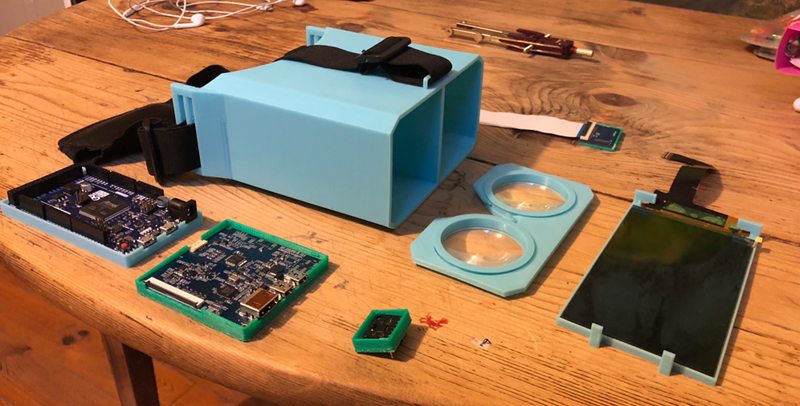Like a lot of 16-year-olds, [Maxime Coutté] wanted an Oculus Rift. Unlike a lot of 16-year-olds, [Maxime] and friends [Gabriel] and [Jonas] built one themselves for about a hundred bucks and posted it on GitHub. We’ll admit that at 16 we weren’t throwing around words like quaternions and antiderivatives, so we were duly impressed.
Before you assume this is just a box to put a phone in like a Google Cardboard, take a look at the bill of materials: an Arduino Due, a 2K LCD screen, a Fresnel lens, and an accelerometer/gyro. The team notes that the screen is what will push the price unpredictably, but they got by for about a hundred euro. At the current exchange rate, if you add up all the parts, they went a little over $100, but they were still under $150 assuming you have a 3D printer to print the mechanical parts.
The system uses two custom libraries that you could use even if you wanted a slightly different project. FastVR creates 3D virtual reality using Unity and WRMHL allows Unity to communicate with an Arduino. Both of these are on the team’s GitHub page, as well.
There was one other member of the team, their math teacher [Jerome Dieudonne] who they call [Sensei]. According to [Jerome] he is “… the theoretician of the team. I teach them math and I help them solving algorithm issues.” He must be very proud and we always applaud when someone takes the time to share what they know with students.
We don’t know what’s next for this group, but we will be keeping an eye on them to see what’s next. Maybe they’ll work on smell-o-vision.
















So, why leave the strap hanging down in the video that blocks the view of the middle section of the display of the headset?
Hi thanks for this article! If you have any questions you can join our Discord Fellowship or ping me: maxime@relativty.com
For the strap I’m sorry if the shoot is bad. If you want a live demo just call me on Skype or any other platform.
Little typo my name is “Maxime Coutté” no more “e” :-)
Thanks for the response Maxime! Please would you make another video and link it here?
Thanks for this article! I’m amazed you liked the project.
Little typo in my name; which is actually “Maxime Coutté”
If you have any questions or suggestions you can join our Fellow on Discord or ping me: maxime@relativty.com
You and your friends (and Sensei, of course) have my deepest respect for engineering such an excellent project! Well done!
Can we please not let “an Oculus” become the generic term for a VR headset?
Indeed. It’s like someone building themselves a game console and say “We built ourselves a Sony!”
In my country Nintendo briefly had such a status. “We bought a Nintendo”, “this kid spends all day playing Nintendo”, are all valid sayings among the elderly.
Used to be Nintendo back in the day (or Atari…) :P
What is the board middle front between the Arduino Due and the GY-521 MPU-6050 module ?
The interface to HDMI. The screen itself has no interface electronics.
It looks like a driver board for the LCD. With the HDMI port, the project is opened up to much better brains.
It’s an HDMIMIPI-DSI board capable of dual 2K resolution. Pretty nifty!
They’ve started popping up on Aliexpress very recently, presumably because China have latched on to the VR craze. I’ve seen the boards go anywhere from $40 – $100, usually as a combo with a high-res OLED display.
Also fun fact: the chip on that board is actually the same chip that’s used in the Oculus and HTC Vive!
> Also fun fact: the chip on that board is actually the same chip that’s used in the Oculus and HTC Vive!
The Rift uses a Bosch BMI055, not a MPU-6050. The DK1 uses the MPU-6000 (similar to MPU-6050 but supports 8 kHz and doesn’t require I²C communication) and the DK2 and the HTC Vive use the MPU-6500 (more gyro sensitivity and supports 32 kHz).
Most MPU also support SPI interfacing at higher speed than I2C.
However Google as part of its Daydream specs demands the MPU has an error smaller than 1%, which not all MPU have.
I know some daydream compatible products use the LSM6DSM though, which is also available at the Chinese sites for around €6.
Is this in any way compatible with steam vr?
This. While this really is a nice project, and a lot of kudos to the guys who built it, it’s just another toy to play around with and then put into a corner because there is nothing that supports it.
(If I can find the time I will built it regardless of that)
If this could be made compatible with already existing system this would be huge IMO.
Valve actually released a supporting SDK for that kind of thing:
https://github.com/ValveSoftware/openvr
So that should help things along.
Even if it was made compatible at the software level, which is certainly possible, it would still lack positional tracking and would be basically useless with existing content. But that’s still a great learning project.
Works on steam games.